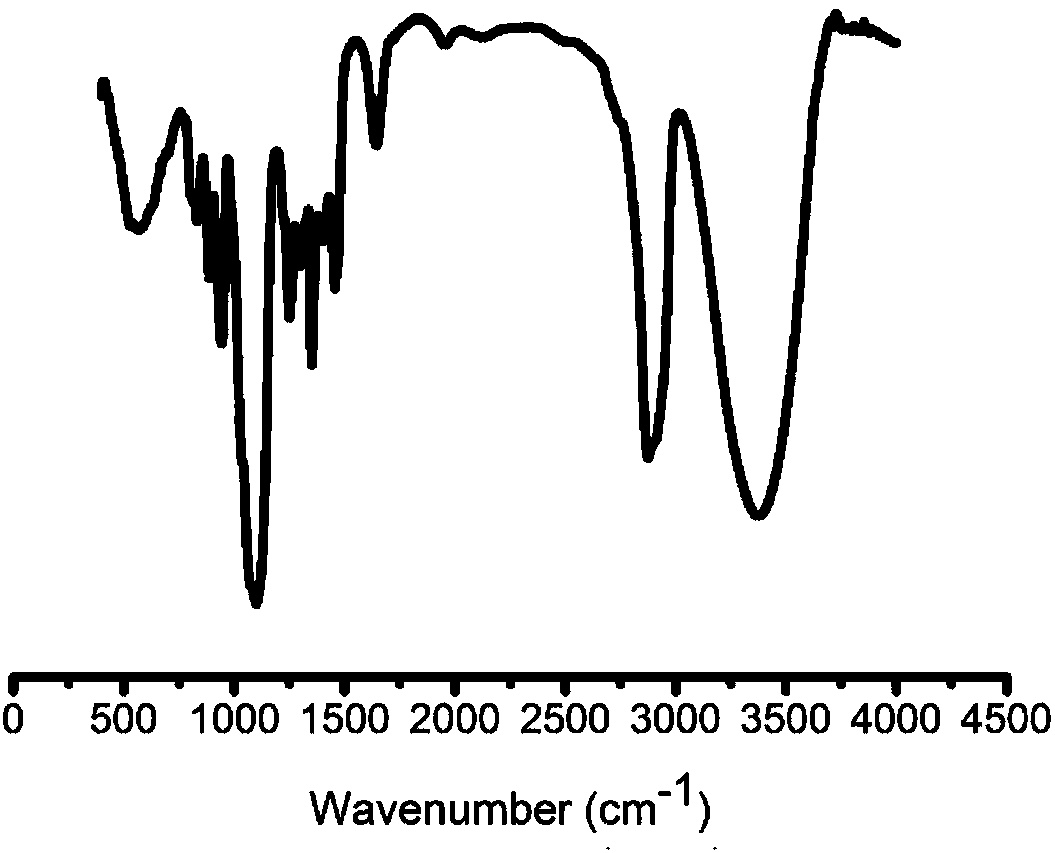Tumor microenvironment response nanoparticle based on peptides dendrimer modified fluorescence carbon dots and preparation method of tumor microenvironment response nanoparticle
A tumor microenvironment and fluorescent carbon dot technology, applied in the field of biomedical materials, can solve the problems of high protein adsorption, poor anti-tumor effect and safety, and slow drug release rate from drug-loaded nanoparticles, so as to achieve drug efficacy and improve anti-tumor effects. Tumor effect, effect of reducing clearance
- Summary
- Abstract
- Description
- Claims
- Application Information
AI Technical Summary
Problems solved by technology
Method used
Image
Examples
Embodiment 1
[0049] The preparation of embodiment 1 nanometer fluorescent carbon dot
[0050] Preparation of nano fluorescent carbon dots by microwave heating method: dissolve 4g glucose in 6mL water and mix well, add 20mL PEG200 under stirring conditions, stir and mix well, then put it in a microwave oven, and microwave it under 800W for 3min to obtain brown Black viscous liquid, after cooling to room temperature, diluted with a small amount of water, then added to a 3500kD dialysis bag, dialyzed with deionized water overnight, passed the obtained solution through a 0.45μm filter membrane, diluted with deionized water to volume 100mL to obtain a concentration of 3.0g / mL nano-fluorescent carbon dots solution.
[0051] Do infrared analysis, particle size and TEM morphology analysis to the above-mentioned prepared nano-fluorescent carbon dots; wherein the infrared spectrum is as follows: figure 2 As shown, the particle size distribution and TEM images are shown in image 3 shown.
[0052...
Embodiment 2
[0055] Embodiment 2 Preparation of mercapto-fluorescent carbon dots
[0056] Take 80mL of the prepared nano fluorescent carbon dot solution, add EDC (1.31g, 6.84mmol) and NHS (0.78g, 6.84mmol), stir and activate for 30min, then add cystamine (0.52g, 3.42mmol) and stir overnight to avoid light , after the reaction, the resulting solution was added to a 3500kD dialysis bag and dialyzed for 24h. The dialysate was deionized water, and the dialysate was changed every 4h. The dialysed solution was collected and stirred overnight by adding DTT (3.52g, 22.86mmol). The resulting liquid was added to the dialysis bag for dialysis for 48 hours, and the dialysate was changed every 4 hours. The dialysate was collected and freeze-dried to obtain a brown solid, which was thiolated nano-fluorescent carbon dots.
[0057] make the resulting product 1 H-NMR scanning, nuclear magnetic spectrum such as Figure 4 (b) shown.
Embodiment 3
[0058] Example 3 Preparation of second-generation peptide dendrimers grafted with arginine-lysine
[0059] Take methyl ester-protected lysine H-Lys-OMe (5.00g, 21.51mmol), N-tert-butoxycarbonyl-N'-(2,2,4,6,7-pentamethyldihydrobenzofuran -5-sulfonyl)-L-arginine Boc-Arg(Pbf)-OH (27.18g, 51.61mmol), EDC·HCl (9.89g, 51.61mmol) and HOBT (6.97g, 51.61mmol) into 100mL In the branch bottle, vacuum-nitrogen cycle three times, add 30mL dichloromethane under nitrogen state and stir to dissolve, then slowly add DIEA (25.58mL, 154.83mmol) under ice bath conditions, react at room temperature for 24h, and collect the reaction solution , the solvent was removed by rotary evaporation, and 60 mL of chloroform was added to dissolve the product, and the dissolved product solution was washed several times with aqueous HCl (1mol / L), aqueous NaOH (1mol / L) and saturated NaCl solution, and the chloroform solution of the organic phase was collected. , add an appropriate amount of anhydrous magnesium s...
PUM
| Property | Measurement | Unit |
|---|---|---|
| particle diameter | aaaaa | aaaaa |
| particle size | aaaaa | aaaaa |
| particle diameter | aaaaa | aaaaa |
Abstract
Description
Claims
Application Information
 Login to View More
Login to View More - R&D
- Intellectual Property
- Life Sciences
- Materials
- Tech Scout
- Unparalleled Data Quality
- Higher Quality Content
- 60% Fewer Hallucinations
Browse by: Latest US Patents, China's latest patents, Technical Efficacy Thesaurus, Application Domain, Technology Topic, Popular Technical Reports.
© 2025 PatSnap. All rights reserved.Legal|Privacy policy|Modern Slavery Act Transparency Statement|Sitemap|About US| Contact US: help@patsnap.com



